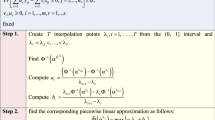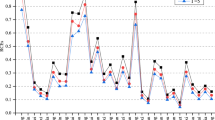Abstract
Data envelopment analysis (DEA) is a classical and prevailing tool for estimating relative efficiencies of multiple decision making units (DMUs). However, sometimes DMUs’ inputs and outputs cannot be observed accurately in practical cases, and hence this paper attempts to propose an uncertain random DEA model to evaluate the efficiencies of DMUs with uncertain random inputs and outputs. The sensitivity and stability of this new model are further analyzed with the aim to figure out the stability radius of each DMU. Finally, a numerical example is presented for illustrating the proposed uncertain random DEA model.
Similar content being viewed by others
References
Andersen, P., & Petersen, N. C. (1993). A procedure for ranking efficient units in DEA. Management Science, 39(10), 1261–1264.
Anderson, T. R., Hollingsworth, K., & Inman, L. (2002). The fixed weighting nature of a cross-evaluation model. Journal of Productivity Analysis, 17(3), 249–255.
Banker, R. D. (1993). Maximum likelihood, consistency and DEA: Statistical foundations. Management Science, 39(10), 1265–1273.
Banker, R. D., Charnes, A., & Cooper, W. W. (1984). Some models for estimating technical and scale efficiencies in data envelopment analysis. Management Science, 30(9), 1078–1092.
Charnes, A., Cooper, W. W., Golany, B., Seiford, L., & Stutz, J. (1985). Foundations of data envelopment analysis for Pareto-Koopmans efficient empirical production functions. Journal of Econometrics, 30(1–2), 91–107.
Charnes, A., Cooper, W. W., & Rhodes, E. (1978). Measuring the efficiency of decision making units. European Journal of Operational Research, 2(6), 429–444.
Cooper, W. W., Park, K. S., & Pastor, J. T. (1999). RAM: A range adjusted measure of inefficiency for use with additive models, and relations to other models and measures in DEA. Journal of Productivity Analysis, 11(1), 5–24.
Doyle, J., & Green, R. (1994). Efficiency and cross efficiency in DEA: Derivations, meanings and the uses. Journal of the Operational Research Society, 45(5), 567–578.
Fare, R., & Grosskopf, S. (2014). Network DEA. Socio-Economic Planning Sciences, 34(1), 35–49.
Jiang, B., Lio, W., & Li, X. (2019). An uncertain DEA model for scale efficiency evaluation. IEEE Transactions on Fuzzy Systems, 27(8), 1616–1624.
Jiang, B., Zou, Z., Lio, W., & Li, J. (2020). The uncertain DEA models for specific scale efficiency identification. Journal of Intelligent and Fuzzy Systems, 38(3), 3403–3417.
Lio, W., & Liu, B. (2018). Uncertain data envelopment analysis with imprecisely observed inputs and outputs. Fuzzy Optimization and Decision Making, 17(3), 357–373.
Liu, B. (2007). Uncertainty theory (2nd ed.). Berlin: Springer.
Liu, B. (2009). Some research problems in uncertainty theory. Journal of Uncertain Systems, 3(1), 3–10.
Liu, B. (2010). Uncertainty theory: A branch of mathematics for modeling human uncertainty. Berlin: Springer.
Liu, Y. H. (2013a). Uncertain random programming with applications. Fuzzy Optimization and Decision Making, 12(2), 153–169.
Liu, Y. H. (2013b). Uncertain random variables: A mixture of uncertainty and randomness. Soft Computing, 17(4), 625–634.
Liu, Y. H., & Ha, M. H. (2010). Expected value of function of uncertain variables. Journal of Uncertain Systems, 4(3), 181–186.
Meng, W., Zhang, D., Qi, L., & Liu, W. (2008). Two-level DEA approaches in research evaluation. Omega, 36(6), 950–957.
Olesen, O. B., & Petersen, N. C. (1995). Chance constrained efficiency evaluation. Management Science, 41(3), 442–457.
Sengupta, J. K. (1982). Efficiency measurement in stochastic input–output systems. International Journal of Systems Science, 13(3), 273–287.
Sexton, T. R., Silkman, R. H., & Hogan, A. J. (1986). Data envelopment analysis: Critique and extensions. Measuring Efficiency: An Assessment of Data Envelopment Analysis, 32, 73–105.
Seiford, L. M., & Zhu, J. (2014). Profitability and marketability of the top 55 US commercial banks. Management Science, 45(9), 1270–1288.
Tone, K. (2002). A slacks-based measure of efficiency in data envelopment analysis. European Journal of Operational Research, 143(1), 32–41.
Wen, M. L. (2015). Uncertain Data Envelopment Analysis. Berlin: Springer.
Acknowledgements
This work was supported by National Natural Science Foundation of China Grant No.61873329, Research Program of Social Sciences of Ocean University of China Grant No.201713011, and Social Science Foundation of Shandong Grant No.17CCXJ19.
Author information
Authors and Affiliations
Corresponding author
Additional information
Publisher's Note
Springer Nature remains neutral with regard to jurisdictional claims in published maps and institutional affiliations.
Appendices
Uncertainty theory
Liu (2007) set up uncertainty theory to analyze the belief degree in 2007 and then Liu (2009) perfected it in 2009. In this appendix, some helpful knowledge is provided which is beneficial to this article. The set function  on a \(\sigma \)-algebra \({\mathcal {L}}\) over a nonempty set \(\varGamma \) is named uncertain measure provided that it meets three axioms below:
on a \(\sigma \)-algebra \({\mathcal {L}}\) over a nonempty set \(\varGamma \) is named uncertain measure provided that it meets three axioms below:
-
1.
Normality Axiom: For the universal set \(\varGamma \),
 .
. -
2.
Duality Axiom: For any event \(\varLambda \),
 .
. -
3.
Subadditivity Axiom: For every countable sequence of events \(\varLambda _1, \varLambda _2, \cdots \), we obtain

Then, Liu (2009) proposed product axiom in 2009.
-
4.
Product Axiom: The product uncertain measure
 in uncertainty spaces
in uncertainty spaces  is an uncertain measure meeting
is an uncertain measure meeting 
where \(\varLambda _k\) are arbitrarily chosen events from \({\mathcal {L}}_{k}\) for \(k=1, 2, \cdots \), respectively.
Definition 2
(Liu 2007) An uncertain variable is a function \(\xi \) from an uncertainty space (\(\varGamma \), \({\mathcal {L}}\),  ) to the set of real numbers such that \(\{\xi \in B \}\) is an event for any Borel set B of real numbers.
) to the set of real numbers such that \(\{\xi \in B \}\) is an event for any Borel set B of real numbers.
Definition 3
(Liu 2007) For an uncertain variable \(\xi \), its uncertainty distribution \(\varPhi \) is

for any real number x.
Based on the definitions above, a frequently used uncertainty distribution can be expressed below:
which is named linear uncertainty distribution and labeled with \({\mathcal {L}}(a,b)\).
Definition 4
(Liu 2009) Uncertain variables \(\xi _1\), \(\xi _2\), \(\cdots \), \(\xi _n\) are said to be independent if

for any Borel sets \(B_{1}\), \(B_{2}\), \(\cdots \), \(B_{n}\) of real numbers.
If an uncertain variable \(\xi \) has a regular uncertainty distribution \(\varPhi (x)\), then the inverse function \(\varPhi ^{-1}(\alpha )\) is named the inverse uncertainty distribution of \(\xi \) (Liu 2010).
Theorem 6
(Liu 2010) Assume \(\xi _{1}, \xi _{2}, \ldots , \xi _{n}\) are independent uncertain variables with regular uncertainty distributions \(\varPhi _{1}, \varPhi _{2},\ldots , \varPhi _{n},\) respectively. When \(f(x_{1}, x_{2}, \ldots , x_{n})\) is continuous, strictly increasing with respect to \(x_{1}, x_{2}, \ldots , x_{m}\) and strictly decreasing with respect to \(x_{m+1}, x_{m+2}, \ldots , x_{n}\), then \(\xi = f(\xi _{1}, \xi _{2}, \ldots , \xi _{n})\) has an inverse uncertainty distribution
For the uncertain variable \(\xi \), its expected value can be figured out by following formula:
if \(\xi \) has a regular uncertainty distribution \(\varPhi \) (Liu 2010).
Theorem 7
(Liu and Ha 2010) Suppose \(\xi _{1}, \xi _{2}, \ldots , \xi _{n}\) are independent uncertain variables with regular uncertainty distributions \(\varPhi _{1}, \varPhi _{2}, \ldots , \varPhi _{n},\) respectively. When \(f(\xi _{1}, \xi _{2}, \ldots , \xi _{n})\) is strictly increasing with respect to \(\xi _{1}, \xi _{2}, \ldots , \xi _{m}\) and strictly decreasing with respect to \(\xi _{m+1}, \xi _{m+2}, \ldots , \xi _{n}\), then
is the expected value of \(f(\xi _{1}, \xi _{2}, \ldots , \xi _{n})\).
Chance theory
Liu (2013b) created chance theory for modeling the phenomenon that uncertainty and randomness simultaneously appear in a system. Some essential definitions and theorems are given in this appendix.
Definition 5
(Liu 2013b) The chance measure of event \(\varTheta \) is

where \(\varTheta \in {\mathcal {L}} \times {\mathcal {A}}\) is an event in a chance space  .
.
Definition 6
(Liu 2013b) An uncertain random variable is a function \(\xi \) from a chance space  to the set of real numbers such that \(\{\xi \in B \}\) is an event in \({\mathcal {L}} \times {\mathcal {A}}\) for any Borel set B of real numbers.
to the set of real numbers such that \(\{\xi \in B \}\) is an event in \({\mathcal {L}} \times {\mathcal {A}}\) for any Borel set B of real numbers.
Definition 7
(Liu 2013b) Let \(\xi \) be an uncertain random variable. Then its chance distribution is defined by
for any \(x \in \mathfrak {R}.\)
Theorem 8
(Liu 2013a) Let \({\eta }_{1},{\eta }_{2},\ldots ,{\eta }_{m}\) be independent random variables with probability distributions \(\varPsi _{1},\varPsi _{2},\ldots ,\varPsi _{m}\), and let \({\tau }_{1},{\tau }_{2},\ldots ,{\tau }_{n}\) be independent uncertain variables with regular uncertainty distributions \(\varUpsilon _{1},\varUpsilon _{2},\ldots ,\varUpsilon _{n}\), respectively. Assume \(f({\eta }_{1},{\eta }_{2},\ldots ,{\eta }_{m},{\tau }_{1},{\tau }_{2},\ldots ,{\tau }_{n})\) is continuous, strictly increasing with respect to \({\tau }_{1},{\tau }_{2},\ldots ,{\tau }_{k}\) and strictly decreasing with respect to \({\tau }_{k+1},{\tau }_{k+2},\ldots ,{\tau }_{n}\). Then the uncertain random variable
has a chance distribution
where \(F(x;{y}_{1},{y}_{2},\ldots ,{y}_{m})\) is the root \(\alpha \) of the equation
For the uncertain random variable \(\xi \), its expected value can be figured out by the theorem below.
Theorem 9
(Liu 2013a) Assume \({\eta }_{1}, {\eta }_{2}, \ldots , {\eta }_{m}\) are independent random variables with probability distributions \(\varPsi _{1}, \varPsi _{2}, \ldots , \varPsi _{m}\), and assume \({\tau }_{1}, {\tau }_{2}, \ldots , {\tau }_{n}\) are independent uncertain variables with uncertainty distributions \(\varUpsilon _{1}, \varUpsilon _{2}, \ldots , \varUpsilon _{n}\), respectively. If f is a measurable function, then
has an expected value
where
is the expected value of the function \(f({y}_{1},{y}_{2},\ldots ,{y}_{m},{\tau }_{1},{\tau }_{2},\ldots , {\tau }_{n})\) for any real numbers \({y}_{1},{y}_{2}\), \(\ldots ,{y}_{m}\), and is determined by \(\varUpsilon _{1}, \varUpsilon _{2},\ldots ,\varUpsilon _{n}\).
Rights and permissions
About this article
Cite this article
Jiang, B., Feng, W. & Li, J. Uncertain random data envelopment analysis for technical efficiency. Fuzzy Optim Decis Making 21, 1–20 (2022). https://doi.org/10.1007/s10700-021-09361-0
Accepted:
Published:
Issue Date:
DOI: https://doi.org/10.1007/s10700-021-09361-0





 .
. .
.
 in uncertainty spaces
in uncertainty spaces  is an uncertain measure meeting
is an uncertain measure meeting 